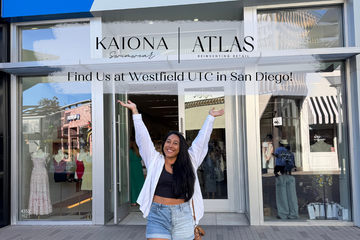To experience the array of colors, marine life, and surprises of a coral reef ecosystem in deep blue seas can be magical. You need very little equipment. A mask, a snorkel, fins, and of course a great swimsuit or fabulous bikini (eco-friendly of course). Corals are loved for their vibrant colors that often shine through the crystal clear water and beautify the undersea landscape. Coral is home to the most fascinating and diverse fish and wildlife. During the warmest summer months, the brilliant colors of these corals have faded. This is due to coral bleaching and is the result of climate change and sea temperature rise, which not only strips away their beautiful color, but can also take their life. What causes coral bleaching? Let’s take a look at how coral reefs are affected and how we bikini-loving beach people can help.
What is coral reef bleaching?
If you’re thinking, what exactly is coral? You’re not alone. Though it may look like colorful rocks, what you’re seeing is actually the hard limestone (calcium carbonate) skeleton of thousands of tiny living animals called coral polyps. There is an algae called zooxanthellae that lives inside each of these coral polyps, which provides the coral with food via photosynthesis. The algae and coral polyps live in symbiosis, which means that they both benefit from the relationship that they have. Zooxanthellae provide food and in return have a safe and protected place to live. This symbiotic relationship is at the core of why corals bleach.
What causes coral bleaching?
-
Climate change
-
Pollution, sedimentation, excess nutrients, changes in salinity
-
Extreme low tides or too much sunlight
Coral bleaching happens when changing conditions in the waters surrounding the coral reefs disrupt the relationship between the coral polyps and algae. When corals get stressed, they “spit out” the algae that live in their tissues and give them most of their color. This causes the coral to turn a ghostly, skeleton white color because you can now see the skeleton through the live transparent tissue. There are many different factors that can cause coral polyps to remove their algae, many of them are related in some way to climate change. Warming ocean temperatures are the main factor. Global temperatures have been increasing at alarming rates in the last several decades. Sea surface temperatures have also increased and changes in weather patterns increase sea level and freshwater flooding, depositing sediments and nutrients onto coral reefs. This is due to an increase in human activities since the industrial revolution.
Although corals can recover and have shown some adaptation mechanisms, bleaching events are becoming more frequent and intense. Corals will not be able to adapt or recover quickly enough between events. Once a coral expels most of its algae, its primary food source has been taken away. The coral lives in a weakened state, struggling to grow, reproduce, and resist disease. Eventually, a coral living in this state will die. Some species of corals are more tolerant to high temperature so there are already shifts in composition and biodiversity occurring worldwide. As warming continues, if rapid reductions in carbon emissions do not occur, research predicts that most corals will be gone within a few decades.
We are at a crossroads where what we do today will determine the fate of our coral reefs. We have the chance to make a positive difference, to be a part of the solution, the movement that helped save our coral reefs. We must reduce our carbon footprint. If we all work together on all levels, we will make a difference. There are many ways you can help the global effort. A few include:
- Thinking of the true cost of everything you buy (the cost to the environment). Was it ethically made? How far away did it come from? Is it sustainable? Can it be recycled or composted?
- Eating lower on the food chain (more plants), picking only what is in season, and consuming local products will also significantly reduce your impact.
- We can become part of the solution by developing, advocating for, and using new earth friendly technologies.
Stay informed about bleaching. Sign up at NOAA’s Coral Reef Watch to receive updates about coral bleaching in your region.
Coral Bleaching in Hawai‘i
According to ancient Hawaiians, coral, or ko‘a in Hawaiian, is the origin of life. The Kumulipo is a Hawaiian creation chant, which tells us that life here originated with the coral polyp. As new life was born, life became more and more complex. From the coral, all other marine life originated, with terrestrial organisms to follow. The Hawaiians understood the deep connection of corals to their livelihood and natural environment. All marine life from fishes, algae, crabs, and turtles are supported by coral reefs and are directly affected by its health. Emphasis has been placed on protecting coral due to its importance culturally, ecologically, economically, and recreationally.
The number one threat to Hawaiian coral reefs is climate change, which causes coral bleaching. Hawai‘i’s first widespread coral bleaching event was in 1996, and then again in 2002. In these two events, coral recovery was high. However, the next bleaching events seen in 2014 and 2015 brought devastation to Hawai‘i coral reefs. Over half of all corals in Hawai‘i bleached, with a 35% mortality rate. Experts now predict that we will have extreme bleaching events like the ones in 2014 and 2015 every six years in Hawai‘i. These massive bleaching events are devastating in Hawai‘i and around the world and are leading to the collapse of the ecosystem. Organizations and research institutes are trying to understand the effects of coral bleaching and ways to mitigate its effects.
The Hawai‘i Institute of Marine Biology (HIMB) has developed an easy tool called the Ko‘a Card that allows anyone to help collect coral reef data.

What is the Hawaiian Ko‘a Card ?
The Ko‘a card is a coral bleaching and health assessment tool that is a useful way for ocean stewards and scientists to collect data on a large scale throughout the Hawaiian Islands. This information can provide detail on the physical health of Hawai‘i coral reefs throughout the year as well as during bleaching events. You can be part of providing a technical solution to inform and improve management of our coral reefs through community monitoring. This will assist in determining where management and research efforts should focus, identifying regions and species of resilience with less bleaching, establishing baselines statewide, and developing and executing rapid response plans. The Hawaiians relied on observations to manage resources. In a similar way, the Hawaiian Ko‘a card gives individuals and communities a sense of kuleana (responsibility) and mālama (stewardship) for the reefs in their area.
The colors on this card were developed through a series of controlled laboratory experiments followed by field validations and surveys. Each color has been linked to the health (e.g., symbiont density, chlorophyll levels, photosynthetic performance) of common coral species in Hawaiʻi. This card works on 17 different species of coral found across the Hawaiian Islands, making it a versatile and efficient way for aspiring marine biologists and others interested in ocean conservation to easily help collect data. The card is designed to be used by anyone regardless of experience, whether you are a coral researcher, a bikini-loving freediver, or a tourist on vacation that has a passion for conservation. Though it is small, it is mighty! Even if you have just 20 minutes to use the card, all data uploaded makes a difference in obtaining a larger picture.
How to record and upload coral reef data
All you have to do is choose 20 coral colonies, record its shape, and match the color on the card to the color of the coral. When you finish collecting this information, simply upload it on the form on the NOAA PacIOOS website to report the data. It will be added to a map with other observations. For a complete breakdown of how to use the Ko‘a card, visit the Coral Reef Ecology Lab website.
Think blue and go green, get involved!
You can get your own biodegradable Ko‘a card and contribute to coral reef conservation on your next snorkel session! Visit the HIMB Coral Reef Ecology Lab website for more information and training videos on how to use your card.
Where to get a Hawaiian Ko‘a card:
- O'ahu - Visit the O'ahu Division of Aquatic Resources office on Punchbowl Street or pick one up at Aaron's Dive Shop in Kailua.
- Kaua‘i - Visit your local Division of Aquatic Resources office or email Sari Pastore from the Limahuli Garden and Preserve at spastore@ntbg.org.
- Maui and Hawai‘i Island - Contact your local Division of Aquatic Resources office.
- University of Hawai‘i Marine Options Program Offices will begin distribution at main campuses and Community Colleges beginning December 2020.






